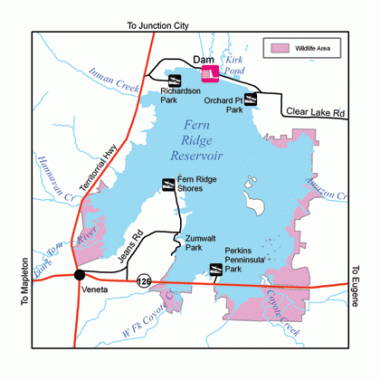
Warmwater fishing in the south Willamette area
The south Willamette area covers the upper Willamette Basin south of Salem and includes the communities of Albany, Corvallis, Eugene, Springfield and Cottage Grove. Fishing for bass and panfish can be outstanding in the Willamette River and its many sloughs, but you'll need a boat for most locations because much of the banks are privately-owned. There also is good warmwater fishing in the area’s larger lakes such as Cottage Grove, Dorena, Foster, and Fern Ridge reservoirs, where crappie and large bass attract both seasoned and causal anglers. There are many smaller ponds inside and near the urban communities that offer great destinations for families and young anglers, or those looking for a quick and convenient fishing trip.

Good warmwater fishing can also be found in the area’s larger lakes such as Cottage Grove, Dorena, Foster and Fern Ridge reservoirs where crappie and large bass attract both seasoned and causal anglers. There are also many smaller ponds inside and near the urban communities that offer great destinations for families, young anglers or those looking for a quick and convenient fishing trip. A variety of warmwater fish are available including: Largemouth Bass | Smallmouth Bass | Bullheads | Black Crappie | White Crappie | Bluegill | Pumpkinseed | Yellow Perch | Redear Sunfish | Green Sunfish | Warmouth | Channel Catfish
Featured waterbody - Fern Ridge Reservoir
With a surface area of 9,000 acres at full pool, Fern Ridge is the largest lake in the Willamette Valley and one of several area flood control reservoirs managed by the US Army Corps of Engineers. It is located on the Long Tom River, which still provides a band of deep water down the middle of what is otherwise a very broad and shallow waterbody. Amazon Creek, Coyote Creek and a number of other smaller tributary streams create many coves and inlets that provide ideal habitat for warmwater fish including largemouth bass, bluegill, brown bullhead catfish and crappie. Located only 12 miles west of Eugene, it is a short drive from valley and coastal communities, and convenient for families and other anglers seeking a weekend destination or quick fishing trip.
The reservoir offers a variety of recreational opportunities in addition to fishing including boating, sailing, water skiing, canoeing and swimming. Boat ramps are located at Richardson Park, Fern Ridge Shores, Perkins Peninsula Park and Orchard Point Park. A windy afternoon may keep anglers with smaller boats off the open water, but they can find shelter in the many inlets and sloughs along the southern edge of the reservoir and in the Long Tom arm. Canoes can be launched at the Long Tom River Nature Trail parking area located off Territorial Rd. on ODFW’s Fern Ridge Wildlife Area. For those without a boat, bank access is good along the dam and at the shoreline parks. A fishing dock at Perkins Peninsula Park provides easy access for young or disabled anglers.
Although Fern Ridge offers outstanding fishing for bass and catfish, crappie are the main attraction. Crappie in Fern Ridge tend to grow more quickly than those in other western Oregon waters and the reservoir often produces fish over 12-inches. The best crappie fishing is in the spring, though some fish can be caught during the warmer summer months. The shoreline along Hwy 126 and Perkins Peninsula is a good area to target. Other locations include the channels where tributary streams enter the lake and along the face of the dam.
Look for fish near vegetation, wood and other submerged structure, or along edges and other drop-off points where the water is less than 10 feet deep. When fishing more open water or along the edges of cover, use light or medium spinning tackle to fish a bobber and jig combination. Start with a red and white crappie jig located about 12 inches below the bobber. Cast out and use a slow retrieve while occasionally jiggling the rod tip to give the jig more action. In areas where weeds or other cover are thick, some anglers prefer to fish one or two jigs using a long rod set-up and heavier line. Drop the jigs into a small hole or opening in the vegetation and hold the rod tip stationary, then give it a short jiggle every 10-20 seconds. Lift the jigs and move to another spot every minute or two if you haven’t had a bite. Use a larger size-6 jig in a neutral or darker color such as gray. Regardless of the method you choose, have a variety of jig colors available because what works at one spot may not work at the next. Also, crappie abundance can go through cycles every few years so check with ODFW for the latest information.
Bass anglers will find a variety of water to fish. Target weedy areas in the reservoir’s shallows during the morning and evening. The deeper creek channels and places where trees, logs, stumps and woody vegetation offer cover -- such as the area around Fern Ridge Shores -- are always a good bet. A good place to start would be the slough areas in and around Coyote Creek and along the southern edge of the reservoir off Hwy 126. The rock along the face of the dam can be productive when water levels are lower. The best fishing will be in the spring when bass are spawning, but you can catch bass any time from spring through fall. Spinnerbaits and brightly-colored soft plastic bait imitations fished using medium to heavy spinning or bait casting tackle and 8- to 12-pound test line are effective.
Bluegill can be caught throughout the reservoir in any of the weedy or other shallow shoreline areas. A hook baited with worm or other panfish bait, and fished under a bobber will minimize snags and frustrations, especially for young anglers. Watch the bobber closely as bluegill are good at stealing bait. Bluegill fishing also is good immediately below the dam in Kirk Pond.



